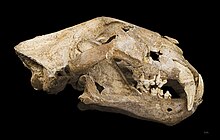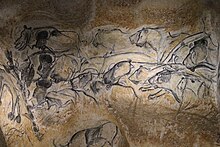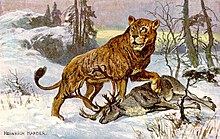Panthera spelaea
| Panthera spelaea | |
|---|---|

| |
| Skeleton in Natural History Museum, Vienna | |
| Scientific classification | |
| Domain: | Eukaryota |
| Kingdom: | Animalia |
| Phylum: | Chordata |
| Class: | Mammalia |
| Order: | Carnivora |
| Suborder: | Feliformia |
| Family: | Felidae |
| Subfamily: | Pantherinae |
| Genus: | Panthera |
| Species: | †P. spelaea
|
| Binomial name | |
| †Panthera spelaea Goldfuss, 1810
| |
| Subspecies | |
| |

| |
| Red indicates the maximal range of Panthera spelaea, blue Panthera atrox, and green Panthera leo. | |
| Synonyms | |
| |
Panthera spelaea, also known as the cave lion or steppe lion,
Taxonomy

Felis spelaea was the
Several authors regarded Panthera spelaea as a subspecies of the modern lion, and therefore as Panthera leo spelaea.[9][10][11][2] One author considered the cave lion to be more closely related to the tiger based on a comparison of skull shapes, and proposed the scientific name Panthera tigris spelaea.[12]
Results from morphological studies showed that it is distinct in cranial and dental anatomy to justify the specific status of Panthera spelaea.[13][14] Results of phylogenetic studies also support this assessment.[15][3][4]
In 2001, the subspecies Panthera spelaea vereshchagini was proposed for seven specimens found in
Evolution

Lion-like
P. spelaea bone fragments excavated in
| |||||||||||||||||||||||||||||||||||||||||||
Characteristics

Carvings and

P. spelaea is also known from the
P. spelaea was thought to have been one of the largest lion species. The skeleton of an adult male found in 1985 near Siegsdorf in Germany had a shoulder height of around 1.2 m (3 ft 11 in) and a head-body length of 2 m (6 ft 7 in) without the tail, similar in size to large modern lions.[26] The size of this male was exceeded by other specimens, with another male reaching 2.5 m (8 ft 2 in) long without the tail.[citation needed] Similarly, footprints attributed to a male cave lion measured 15 cm (6 in) across. The heaviest Panthera spelaea was estimated to weigh 339 kg (747 lb).[27]
This shows that P. spelaea would have been up to or over 12% larger than modern lions, but still smaller than the earlier Panthera fossilis or the American lion (P. atrox). Cave paintings almost exclusively show hunting animals without a mane, suggesting that males were indeed maneless.[28][29] P. spelaea had a relatively longer and narrower muzzle compared to that of the extant lion. Despite this, the two species do not exhibit major differences in morphology.[6] Like modern lions, females were smaller than males.[30]
In 2016, hair found near the
Distribution and habitat

P. spelaea formed a contiguous population from western Europe to the
The oldest known fossils dated with radiocarbon dating were excavated in northeastern Russia and were radiocarbon dated at 62,400 years old.[6] Phalanx bones excavated in Spain's La Garma cave complex were radiocarbon dated to 14,300–14,000 years old.[40] The youngest known fossils are dated 11,925 years old and originated near Fairbanks, Alaska.[6] In Western Europe, however, P. spelaea may have survived into the Early Holocene.[41]
In 2008, a well-preserved mature cave lion specimen was unearthed near the
The cave lion probably inhabited predominantly open habitats such as steppe and grasslands although it would have also have occurred in open woodlands as well.[6] It also lived in mountainous regions, likely because it sought out hibernating bears in montane caves as a food source during the winter.[44]
Discoveries

In 2015, two frozen cave lion cubs, estimated to be between 25,000 and 55,000 years old, were discovered close to the
Research results indicate that the cubs were likely barely a week old at the time of their deaths, as their milk teeth had not fully erupted. Further evidence suggests the cubs were hidden at a den site until they were strong enough to follow their mother back to the pride, as with modern lions. Researchers believe that the cubs were trapped and killed by a landslide, and that the absence of oxygen underground hindered their decomposition and allowed the cubs to be preserved in such good condition. A second expedition to the site where the cubs were found was planned for 2016, in hopes of finding either the remains of a third cub or possibly the cubs' mother.[48]In 2017, another frozen specimen, thought to be a lion cub, was found in Yakutia on the banks of the Tirekhtyakh River (
Paleobiology

P. spelaea inhabited colder environments such as
Isotopic analyses of bone
Extinction
The extinction of the Eurasian cave lion was multifaceted, being attributable to a combination of human activity, the decline of the mammoth steppe, and changes in the herbivore guild.[60] There is direct evidence of human hunting of cave lions and exploitation of their pelts for ritualistic purposes during the Magdalenian, which was likely an important factor contributing to their ultimate demise.[40]
See also
- History of lions in Europe
- Megafauna
- Panthera atrox
- Panthera blytheae
- Panthera gombaszoegensis
- Panthera palaeosinensis
- Panthera shawi
- Panthera youngi
- Panthera zdanskyi
- Panthera leo sinhaleyus
- Panthera leo fossilis
References
- .
- ^ PMID 15012963.
- ^ S2CID 46716748. Archived from the original(PDF) on 21 January 2012.
- ^ hdl:10576/22920.
- ^ PMID 32366643.
- ^ .
- ^ Goldfuss, G. A. (1810). Die Umgebungen von Muggensdorf. Erlangen: Johann Jakob Palm.
- .
- ^ Kurtén, B. (1968). Pleistocene Mammals of Europe. London: Weidenfeld and Nicolson.
- ^ Hemmer, H. (1974). "Untersuchungen zur Stammesgeschichte der Pantherkatzen (Pantherinae) Teil 3. Zur Artgeschichte des Löwen Panthera (Panthera) leo (Linnaeus, 1758)". Veröffentlichungen der Zoologischen Staatssammlung 17: 167–280.
- ^ Turner, A. (1984). "Dental sex dimorphism in European lions (Panthera leo L.) of the Upper Pleistocene: palaeoecological and palaeoethological implications". Annales Zoologici Fennici. 21: 1–8.
- .
- ^ Spassov, N. & Iliev, N. (1994). "Animal remains from the submerged Late Eneolithic – early Bronze Age settlements in Sozopol (South Bulgarian Black Sea Coast)". Proceedings of the International Symposium VI. Thracia Pontica. pp. 287–314.
{{cite book}}: CS1 maint: location missing publisher (link) - .
- S2CID 84497516.
- ^ Baryshnikov, G. F. & Boeskorov, G. (2001). "The Pleistocene cave lion, Panthera spelaea (Carnivora, Felidae) from Yakutia, Russia". Cranium. 18 (1): 7–24.
- ^ PMID 32724178.
- ^ .
- ^ a b Chauvet, J.-M.; Brunel, D. E. & Hillaire, C. (1996). Dawn of Art: The Chauvet Cave. The oldest known paintings in the world. New York: Harry N. Abrams.
- ^ PMID 24382145.
- .
- ^ Leroi-Gourhan, A.; Allain, J. (1979). Lascaux inconnu. XXIIe supplement à "Gallia Préhistoire". Paris.
{{cite book}}: CS1 maint: location missing publisher (link) - .
- ISBN 978-0-297-83588-2.
- ^ Guthrie, R. D. (2005). The Nature of Paleolithic Art. Chicago: University of Chicago Press.
- doi:10.7485/QU62_4.
- doi:10.7287/peerj.preprints.2327v2. Archived from the original(PDF) on 20 September 2022. Retrieved 15 March 2021.
- ISBN 978-3-8062-1734-6.
- ISBN 3-8062-1734-3.
- .
- .
- doi:10.5334/oq.aa.
- hdl:10651/54312.
- PMID 34628301. Retrieved 22 March 2024 – via Elsevier Science Direct.
- ^ Sabol, Martin; Döppes, Doris (January 2020). "The first radiocarbon dating of a cave lion fossil from the Slovakian Western Carpathians". Acta Geologica Slovaca. 11 (1): 11–14 – via ResearchGate.
- ISSN 0891-2963. Retrieved 24 March 2024 – via Taylor and Francis Online.
- . Retrieved 24 March 2024 – via Elsevier Science Direct.
- ISSN 1040-6182. Retrieved 22 March 2024 – via Elsevier Science Direct.
- ^ Sabol, M. (2011). "A record of Pleistocene lion-like felids in the territory of Slovakia". Quaternaire. Hors-série (4): 215−228.
- ^ PMID 27783697.
- . Retrieved 24 March 2024.
- .
- S2CID 133453976. Archived from the original(PDF) on 20 February 2020.
- .
- ^ "Extinct lion cubs found in Siberia are up to 55,000 years old – latest test results reveal". The Siberian Times. 3 November 2016. Retrieved 12 November 2017.
- ^ Koryakina, A. (2015). "Meet this extinct cave lion, at least 10,000 years old – world exclusive". The Siberian Times. Retrieved 29 October 2015.
- ^ Black, R. (2015). "Frozen Cave Lion Cubs from the Ice Age Found in Siberia". National Geographic News. National Geographic. Archived from the original on 26 February 2021. Retrieved 29 October 2015.
- ^ / "Whiskers still bristling after more than 12,000 years in the Siberian cold". The Siberian Times. 2015. Retrieved 25 November 2016.
{{cite news}}: Check|url=value (help) - ^ "Extinct cave lion cub in 'perfect' condition found in Siberia rising cloning hopes". The Siberian Times. 2017. Retrieved 12 November 2017.
- ^ Gertcyk, O. (2018). "Cute first pictures of new 50,000 year old cave lion cub found perfectly preserved in permafrost". The Siberian Times. Retrieved 16 September 2018.
- ^ Gertcyk, O. (9 August 2021). "Meet Sparta, the 'best preserved ice age animal ever found'". The Siberian Times. Retrieved 13 August 2021.
- ^ Bölsche, W. & Harder, H. (1900). Tiere der Urwelt. Serie III. Wandsbek-Hamburg: Verlag der Kakao-Compagnie Theodor Reichardt.
- ^ .
- S2CID 86638786.
- .
- ISSN 0277-3791. Retrieved 4 February 2024 – via Elsevier Science Direct.
- S2CID 129706533.
- .
- ISSN 1040-6182.
- ISSN 1040-6182. Retrieved 22 March 2024 – via Elsevier Science Direct.
External links
- Prehistoric cats and prehistoric cat-like creatures, from the Messybeast Cat Resource Archive
- The mammoth and the flood, volume 5, chapter 1, by Hans Krause.
- Hoyle and cavetigers Archived 13 January 2016 at the Wayback Machine, from the Dinosaur Mailing List. (Groiss)
- Photo-reconstruction of Panthera spelaea, by paleoartist Roman Uchytel
